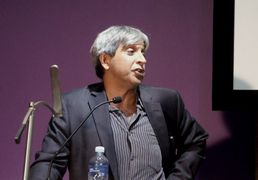BUBBLES in the primordial soup. Things swim, grow bored, then venture on to land. A rock arrives from outer space killing a lot of large lizards. Mammals replace them. They babble and chatter to one another, warring and mating.
The less hairy mammals develop a proud oratory tradition that sets them apart. Empires rise and fall, wars are waged, riots fill the streets and in a faraway land, a president with a snappy tie thumps a podium and says, ‘Yes we can!’.
That covers the history of public speaking. Now let’s get practical. How do you present without slides?
...
"DEATH by PowerPoint." That’s the common term, coined by Angela Garber, bandied about by bored delegates and sent covertly from phone to phone in stuffy boardrooms. "PowerPoint poisoning" is another term, and had its genesis in Dilbert, the office-life comic strip by Scott Adams.
In the beginning, it was a really good idea. It is not the Microsoft program’s fault that it all went wrong. It is the obsessive, compulsive, yearning, mindless, brainwashed, mewling, needling, squirming, frightening need for PowerPoint that is actually the problem.
And through no fault of its own, PowerPoint has been used to visit more pain on professional people in a shorter space of time than the global recession and multilevel marketing combined.
The problems are misuse and overuse.
Misuse occurs when we bravely pack the entire script of War and Peace and the history of Western economic development onto a single slide, then say things like, "I know you probably can’t see this, but …"
And overuse has strangled the efficacy of PowerPoint until Bill Gates’ brilliant baby has been rendered a psychological sedative.
More zombies have been created in conferences through PowerPoint poisoning than any other single cause. At the time of writing this, the number is about half the human race — lending credence to the fear that half of us will ultimately rise up and eat the other half.
As a professional speaker, I vividly recall the conferences at which I’ve heard a presenter open with, "I won’t be using a single PowerPoint slide in my presentation", only to receive thunderous applause, sometimes from a standing audience.
So how did this curious force rise to power? How did we miss the signs of impending apocalypse?
The program was developed under the title Presenter, but renamed PowerPoint for its launch on May 22 1990. It was bundled with the Microsoft Office package, and has enjoyed a symbiotic relationship ever since.
By 2012, it had been installed on more than a billion computers and claimed 95% of the presentation software market share.
...
SADLY, PowerPoint is no longer as effective as it once was in helping us to communicate clearly and effectively. In fact, it tends to hinder. Instead of making thoughts come alive, it smothers them in a molasses of sameness.
It turns brilliance into bullet points and inspired ideas into horrid little charts, graphs, dots, dashes, pies, columns, tables and squiggly lines. It takes the passionate free-flow and colourful versatility of language and reduces it to a boxed-in accompaniment.
Because of the way its parameters force thought through predetermined channels, it makes us all sound horribly similar.
One of its downfalls is that, no matter how well you use its myriad tricks, everyone else is using it too. And so even the most trained and effective PowerPoint devotees are just marginally more developed sheep.
I want to be frank, lest I am ever accused of sneaking up on you with a covert agenda: I don’t like PowerPoint. By not using it, you’ll stand out from the crowd. If everybody does it, and you don’t — and your presentation is better — they will notice. The key, of course, is that it must actually be better.
Most presenters open by showing a bold headline and then reading it out loud — which is amateurish — or worse, by fiddling with a problematic projector. You will simply walk out in front of your audience, command the space, connect with them visually and psychologically, take hold of their minds and imaginations, look every bit the confident thought leader, and begin a powerful mental journey in which you guide them towards your desired outcomes. It changes your voice. Ever received that intrusive phone call from a telemarketer, usually around dinner time? Ever been able to tell beyond all doubt that the person is reading a script at you? You can hear it in the voice. The speech patterns are not authentic.
The same applies when we use rigid PowerPoint guidelines: our speech sounds stilted and rehearsed. They become boxed in by the restraints of the format and we rob ourselves of the fire and conviction that are the heart and soul of public speaking.
Dumping PowerPoint gives you agility in your content and agility in your timing. A speaker stuck to slides is a terrible thing. The speaker before him may steal his thunder by delivering his message and he will have no choice but to duplicate, because the slides are already done and there’s no time to change them.
...
WORSE still is the presenter who knows that their slides are irrelevant: "I’ll just skip past this slide … and this one … and the next one…". Talk about wasting an audience’s time. And creating a poor impression of yourself, your brand, your cause or your organisation. It’s enough to unsell a great idea.
When you are not being propelled along by slides, you are able to be more agile. You are able to customise your information to that audience and to that moment.
You won’t be forced to go overtime by having too many slides. People love speakers who keep to time. They buy flowers for them, write songs about them, fling panties at them and immortalise them in marble.
Most presentations follow the format of a growing explanation, leading to a resolution. In other words, you build your point until the audience finally gets it.
While you are holding your audience in the anticipation phase, they will usually pay attention. But crucially, as soon as they "get it", they will tend to drift off.
PowerPoint slides allow the audience to get it before you have explained it. The audience reads ahead, gets it, and then switches off, as they wait for you to catch up.
Inexperienced presenters tend to assume that not having a PowerPoint guide will make their job more stressful, not less. This is not true. Using PowerPoint effectively constitutes an additional skill set.
There is nothing quite like the natural high of having an audience hanging on your every word. PowerPoint slides do not allow this. They destroy natural rhythm, which is one part of eloquence.
Preparing slides can be monstrously, disastrously time-consuming. That’s not a big deal for a professional speaker, who might present the finished product hundreds, if not thousands of times in future, legitimising his or her time investment.
But for Joe Cubicle, who has but one talk to prepare, it can entail hours, even days of preparation. And the preparation is, itself, a false investment in time. Joe is not actively working on persuasive things to say and clever techniques by which to say them.
The hours of design work are merely design work — not prep work — because Joe is wasting time tinkering with aesthetics.
• Kruger is a professional speaker and business author. This is an edited extract of his latest book, How to Make Your Point Without PowerPoint, published by Penguin

Standing up and addressing your audience, making eye contact, and actually talking to them, beats PowerPoint the author argues. Picture: ISTOCK
BUBBLES in the primordial soup. Things swim, grow bored, then venture on to land. A rock arrives from outer space killing a lot of large lizards. Mammals replace them. They babble and chatter to one another, warring and mating.
The less hairy mammals develop a proud oratory tradition that sets them apart. Empires rise and fall, wars are waged, riots fill the streets and in a faraway land, a president with a snappy tie thumps a podium and says, ‘Yes we can!’.
That covers the history of public speaking. Now let’s get practical. How do you present without slides?
...
"DEATH by PowerPoint." That’s the common term, coined by Angela Garber, bandied about by bored delegates and sent covertly from phone to phone in stuffy boardrooms. "PowerPoint poisoning" is another term, and had its genesis in Dilbert, the office-life comic strip by Scott Adams.
In the beginning, it was a really good idea. It is not the Microsoft program’s fault that it all went wrong. It is the obsessive, compulsive, yearning, mindless, brainwashed, mewling, needling, squirming, frightening need for PowerPoint that is actually the problem.
And through no fault of its own, PowerPoint has been used to visit more pain on professional people in a shorter space of time than the global recession and multilevel marketing combined.
The problems are misuse and overuse.
Misuse occurs when we bravely pack the entire script of War and Peace and the history of Western economic development onto a single slide, then say things like, "I know you probably can’t see this, but …"
And overuse has strangled the efficacy of PowerPoint until Bill Gates’ brilliant baby has been rendered a psychological sedative.
More zombies have been created in conferences through PowerPoint poisoning than any other single cause. At the time of writing this, the number is about half the human race — lending credence to the fear that half of us will ultimately rise up and eat the other half.
As a professional speaker, I vividly recall the conferences at which I’ve heard a presenter open with, "I won’t be using a single PowerPoint slide in my presentation", only to receive thunderous applause, sometimes from a standing audience.
So how did this curious force rise to power? How did we miss the signs of impending apocalypse?
The program was developed under the title Presenter, but renamed PowerPoint for its launch on May 22 1990. It was bundled with the Microsoft Office package, and has enjoyed a symbiotic relationship ever since.
By 2012, it had been installed on more than a billion computers and claimed 95% of the presentation software market share.
...
SADLY, PowerPoint is no longer as effective as it once was in helping us to communicate clearly and effectively. In fact, it tends to hinder. Instead of making thoughts come alive, it smothers them in a molasses of sameness.
It turns brilliance into bullet points and inspired ideas into horrid little charts, graphs, dots, dashes, pies, columns, tables and squiggly lines. It takes the passionate free-flow and colourful versatility of language and reduces it to a boxed-in accompaniment.
Because of the way its parameters force thought through predetermined channels, it makes us all sound horribly similar.
One of its downfalls is that, no matter how well you use its myriad tricks, everyone else is using it too. And so even the most trained and effective PowerPoint devotees are just marginally more developed sheep.
I want to be frank, lest I am ever accused of sneaking up on you with a covert agenda: I don’t like PowerPoint. By not using it, you’ll stand out from the crowd. If everybody does it, and you don’t — and your presentation is better — they will notice. The key, of course, is that it must actually be better.
Most presenters open by showing a bold headline and then reading it out loud — which is amateurish — or worse, by fiddling with a problematic projector. You will simply walk out in front of your audience, command the space, connect with them visually and psychologically, take hold of their minds and imaginations, look every bit the confident thought leader, and begin a powerful mental journey in which you guide them towards your desired outcomes. It changes your voice. Ever received that intrusive phone call from a telemarketer, usually around dinner time? Ever been able to tell beyond all doubt that the person is reading a script at you? You can hear it in the voice. The speech patterns are not authentic.
The same applies when we use rigid PowerPoint guidelines: our speech sounds stilted and rehearsed. They become boxed in by the restraints of the format and we rob ourselves of the fire and conviction that are the heart and soul of public speaking.
Dumping PowerPoint gives you agility in your content and agility in your timing. A speaker stuck to slides is a terrible thing. The speaker before him may steal his thunder by delivering his message and he will have no choice but to duplicate, because the slides are already done and there’s no time to change them.
...
WORSE still is the presenter who knows that their slides are irrelevant: "I’ll just skip past this slide … and this one … and the next one…". Talk about wasting an audience’s time. And creating a poor impression of yourself, your brand, your cause or your organisation. It’s enough to unsell a great idea.
When you are not being propelled along by slides, you are able to be more agile. You are able to customise your information to that audience and to that moment.
You won’t be forced to go overtime by having too many slides. People love speakers who keep to time. They buy flowers for them, write songs about them, fling panties at them and immortalise them in marble.
Most presentations follow the format of a growing explanation, leading to a resolution. In other words, you build your point until the audience finally gets it.
While you are holding your audience in the anticipation phase, they will usually pay attention. But crucially, as soon as they "get it", they will tend to drift off.
PowerPoint slides allow the audience to get it before you have explained it. The audience reads ahead, gets it, and then switches off, as they wait for you to catch up.
Inexperienced presenters tend to assume that not having a PowerPoint guide will make their job more stressful, not less. This is not true. Using PowerPoint effectively constitutes an additional skill set.
There is nothing quite like the natural high of having an audience hanging on your every word. PowerPoint slides do not allow this. They destroy natural rhythm, which is one part of eloquence.
Preparing slides can be monstrously, disastrously time-consuming. That’s not a big deal for a professional speaker, who might present the finished product hundreds, if not thousands of times in future, legitimising his or her time investment.
But for Joe Cubicle, who has but one talk to prepare, it can entail hours, even days of preparation. And the preparation is, itself, a false investment in time. Joe is not actively working on persuasive things to say and clever techniques by which to say them.
The hours of design work are merely design work — not prep work — because Joe is wasting time tinkering with aesthetics.
• Kruger is a professional speaker and business author. This is an edited extract of his latest book, How to Make Your Point Without PowerPoint, published by Penguin
























Change: 2.48%
Change: 2.53%
Change: 2.08%
Change: 1.97%
Change: 5.33%
Data supplied by Profile Data
Change: 0.00%
Change: 0.00%
Change: 2.48%
Change: 0.00%
Change: 0.00%
Data supplied by Profile Data
Change: 0.44%
Change: 0.11%
Change: -0.76%
Change: -0.92%
Change: -0.23%
Data supplied by Profile Data
Change: 0.00%
Change: 0.00%
Change: 0.00%
Change: 0.00%
Change: 0.00%
Data supplied by Profile Data